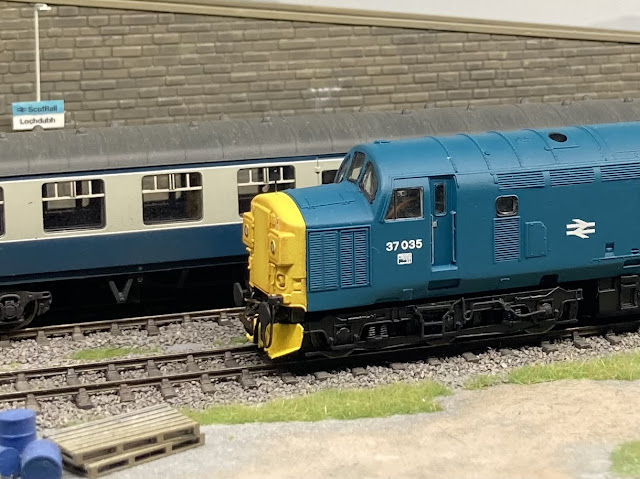The English Electric Type 3, The ‘Tractor’, the British Rail Class 37 is a locomotive I have enjoyed owning in miniature for three decades…
From my first to my last they’ve spanned two gauges and three manufacturers, barely touching the plethora of available models over the same period. Interesting, well, slightly, is the fact that the first, the first after ‘the teenage gap’ and the most recent (here) all share the same body form, probably my favourite, the plated split headcode.
For my ‘Scottish’ day dream I wanted another split headcode 37, in BR blue. It needed to have cut away buffer cowling, plated head codes, non plated boiler, RETB aerial but no headlight. Oh and ploughs!
A suitable donor model, one of the recent ‘Dutch’ liveried examples, was acquired before Christmas. This more recent Graham Farish tooling dates from the noughties and appears to be a shrunken version of the OO model of the same period, the one that formed the basis for my last three 1/76 models. This means largely accurate and well captured character of these distinctive prototypes. However, as with the OO model the biggest compromise is ride height, that was jacked up by the designer to allow it to traverse trainset curves with overscale flanges. Whilst I don’t plan to do anything with the latter, I don’t have any of the former so lowering was definitely on the cards here.

This blog pulls together some photos that have appeared previously to tell the complete story. The model was stripped back to bare plastic in IPA and modifications to the body included removal of the headlight on the noses as well as the access door on the side next to the 3 grills. As the noses are removable they were painted separately (no difficult masking) and Fox decals were used to relieve the slab like blue finish.
Lowering (shown above too) is achieved by some minor surgery. The body has some ribs with clips at the bottom, the latter need carving off. The cab interiors are removed. The lighting contact boards at each end of the chassis are notched, increasing the size of this notch allows them to be pushed lower. The fuel tank is lowered. I aim for around 1mm all around, which captures the heft of these brutes much better. It was pleasing to see how close I got with the latest model (below right) against my previous efforts (left).
On this model I wanted to add more to the chassis and so some photos I took many years ago came in to use (
here and
here) for building up the speedo drive on one of the trucks. The last thing is adding the brake chains (!) which looks feasible but I’ve not managed to secure the chain to the lever yet (it’s blackened and doesn’t take to superglue very well). I shall persist.
So as things stand today she is sat waiting for weathering, but posed below (and top) on Lochdubh has all the promise of the model I saw in my mind when I started - the feeling of attraction, of warmth to this ugly machine is present, it’s almost like the split headcode is like a face? Anyhow, it’s a long held feeling and one that is wonderful to exercise now in N gauge.
When you’re working on a model, in any scale, one intended to become ‘a lead actor’ the choices you make in what to include and what to overlook are very personal. Yes, there are plastic moulded handrails, no car headlight (yet!) and perhaps other details I don’t see - but this isn’t intended to be a scale precision model, it’s a memory machine, an emotional engine to drive our hearts and tell our stories. I love this hobby, this craft. Thanks for reading today, until next time, more soon…
Donate
I love writing and creating material for the blog. If you enjoy what you read and engage with I would be appreciative of any donation, large or small, to help me keep it advert and restriction free.






A hefty, brutish beauty, even shrunk to 1:148 - bring on the next installment!
ReplyDeleteThanks James. Brutish indeed, I’ll finish off part 2 this week.
Delete